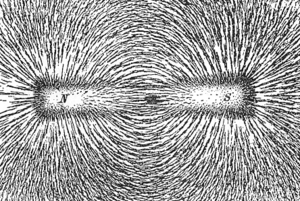Magnetism facts for kids

In physics, magnetism is a special force that can pull objects closer (attract) or push them away (repel). This happens with objects that have magnetic materials like iron inside them. Think of it as a hidden power that some things have to affect other things without even touching them!
Contents
Magnets and Their Power
Magnets are objects that create magnetism. Some magnets are permanent, meaning they always have this power. Others are called electromagnets, and they only become magnetic when electricity flows through them.
When a magnet is near a magnetic object, like a paperclip, the magnet pulls the object towards it. This is called magnetic attraction. But magnets can also push other magnets away! This is called repulsion. Most things that are attracted to magnets contain iron. Other metals, like aluminium, usually aren't attracted to magnets.
The Invisible Magnetic Field
Around every magnet, there's an invisible area called a "magnetic field". If a magnetic object enters this field, the magnet will attract it. If the object is outside the magnetic field, the magnet won't affect it. This is why a magnet has to be close to an object to pull it.
Magnets have two ends, called poles: a north pole and a south pole. These poles are very important for how magnets interact:
- If you put two north poles together, they will push each other away (repel).
- If you put two south poles together, they will also push each other away (repel).
- But if you put a north pole near a south pole, they will pull each other closer (attract) and stick together! It can even be hard to pull them apart.
How Magnets Get Their Power
Magnetism comes from tiny particles inside atoms called electrons. These electrons are always spinning. When many electrons in a material spin in the same direction, they create a strong magnetic force. In a magnet, lots of electrons are spinning together in an organized way.
You can even make a small piece of iron magnetic! If you rub it with a strong magnet, the passing magnet makes the electrons in the iron start spinning in the same direction, just like a basketball player spinning a basketball. This turns the iron into a temporary magnet.
Cool Uses for Magnets
Magnets have been useful for a very long time. Long ago, explorers found that a special magnet could be used as a compass. A compass always points north and south, helping people find their way.
Electromagnets: Magnets You Can Turn On and Off
Electromagnets are different from regular magnets because they only work when electricity is flowing through them. An electric current creates a magnetic field. If you wrap a wire into a coil, the electrons spinning around the coil make an even stronger magnetic field.
Often, electromagnets are made by wrapping a coil of wire around a large piece of metal, usually iron. When current flows through the wire, the iron inside becomes a powerful magnet. When the electricity is turned off, the magnetism disappears.
Electromagnets are used in many everyday items, like computers, televisions, radios, and even doorbells! Large electromagnets can be strong enough to lift heavy objects in scrapyards.
Electromagnetic Waves: Invisible Messengers
Did you know that magnetism and electricity are connected? They create something called electromagnetic waves. These waves include things like radio waves and even light waves!
Electromagnetic waves are super important for communication. They are used for broadcasting radio and TV signals, and for sending information through optical fiber cables. They have many other uses too, like in microwave ovens and X-ray machines.
Earth's Own Giant Magnet
Our planet Earth is like a giant magnet! It has its own magnetic field that protects us from harmful radiation from space.
The North Magnetic Pole
The North Magnetic Pole is a specific spot in the northern hemisphere where Earth's magnetic field points straight down. It's close to, but not exactly the same as, the Geographic North Pole (the very top of the Earth).
There's also a South Magnetic Pole in the southern hemisphere. Because Earth's magnetic field isn't perfectly balanced, a line drawn between the North and South Magnetic Poles doesn't go straight through the center of the Earth.
The North Magnetic Pole actually moves over time! This is because of changes happening deep inside the Earth's core. For example, in 2001, it was near Ellesmere Island in northern Canada. By 2015, it had moved even further east.
When Earth's Poles Flip!
Believe it or not, Earth's magnetic poles have flipped many times throughout history! This means the North Magnetic Pole becomes the South Magnetic Pole, and vice versa. This usually happens every million years or so, but it can vary a lot.
Before a flip, Earth's magnetic field gets weaker and moves around, like a spinning top wobbling before it falls over. Scientists know about these "flip-flops" by studying the magnetism in rocks on the sea floor, especially near places like the mid-Atlantic ridge. Here, lava slowly comes out of a crack in the sea floor and cools. As it cools, tiny iron oxide molecules inside the lava line up with Earth's magnetic field at that time. By looking at these rocks, scientists can see a record of all the past magnetic flips!
The most recent big flip happened about 780,000 years ago. There was also a shorter event about 41,000 years ago during the last ice age, which scientists call an "excursion" because it didn't last as long as a full reversal.
Images for kids
-
Ferrofluid "spiked" up by a cube neodymium magnet, showing its magnetic field.
-
Lodestone, a natural magnet, attracting iron nails. Ancient humans discovered magnetism from lodestone.
-
A live frog floating inside a strong magnetic field (about 16 teslas). This shows how even non-magnetic things can be affected by very strong fields.
See also
 In Spanish: Magnetismo para niños
In Spanish: Magnetismo para niños






